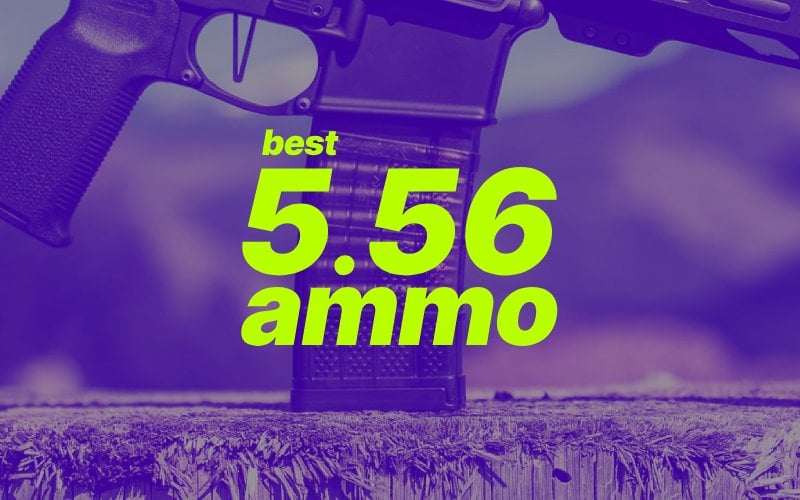
Today, America’s most beloved rifle platform, the AR-15, is typically manufactured in 5.56mm NATO, though there are options in non-traditional calibers, such as .300 AAC Blackout and 6.5 Grendel. Alternative cartridges bring their benefits and downsides to the platform, eventually making it more suitable for one application and less suitable for others. However, the 5.56 NATO will always be considered the best AR-15 round due to its impressive versatility. This guide to the best 5.56 ammo will help you pick the right rounds for your application and fine-tune your setup for the task ahead, whether it’s range practice or home defense.
History of the 5.56 NATO
In the 50s, the US Army outlined the requirement for the cartridge to be used in the future lightweight small-caliber rifle that would become a new standard-issue combat rifle for the military. In particular, these requirements included a .22 caliber bullet that would have ballistics of the 30-06 Springfield, retain subsonic velocity at 500 yards, and penetrate a steel helmet and a .135-inch steel plate at this distance. The cartridge should allow for a 20-round magazine capacity, rifle weight not exceeding 6 pounds, and switch from semi-auto to full-auto.
As you see, the development of a cartridge is inseparable from the development of the rifle in which it was going to be used. The result was the civilian .223 Remington cartridge intended for the AR-15 rifle introduced by the Armalite in the late 50s. Several years later, the military adopted the new combo as the M16 rifle and the 5.56 NATO cartridge.
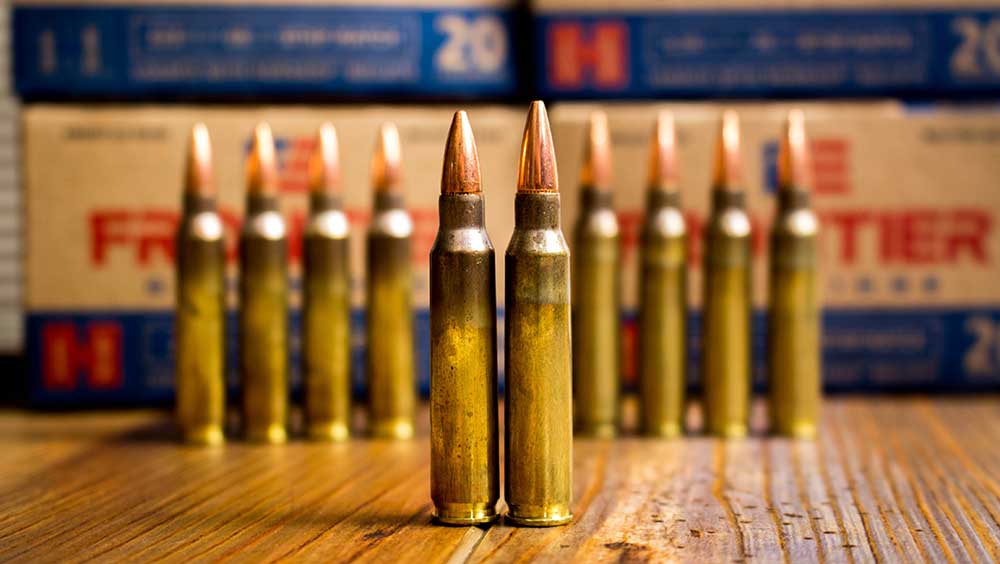
5.56 NATO vs. 223 Rem
Though the 5.56 NATO was developed based on the .223 Remington, it doesn’t mean you can use the cartridges interchangeably. Both of them are nearly identical in terms of the external dimensions. The difference is inside the case and, surprisingly, the rifle.
The 5.56 NATO has slightly thicker walls and, thus, less case capacity, which leads to more pressure from burning the same amount of powder in a smaller space. It’s hard to compare the cartridges in terms of pressure since civilian and military testing techniques are different. But typically, the 5.56 NATO is a higher-pressure round than the .223 Remington.
Another difference lies in the rifle chamber. Everything in a 5.56 chamber is longer and thicker to withstand the higher pressures of the 5.56 cartridge. It means it’s completely safe to use .223 ammo with a 5.56 rifle, but it’s not recommended to do the other way around. A .223 chamber merely has less space for the 5.56 round to build up the pressure safely.
Though many shooters fire the 5.56 NATO from the .223 Rem rifle and don’t experience any immediate malfunctions and accidents, repeated exposure to higher pressures can lead to problems later. So you’d better stick to your rifle specifications.
5.56 Ammo Types: M855 vs M193
Before we touch on what is the best 5.56 ammo, we should run through the types of 5.56 ammo for you to choose the right load for your application. When the military created its own variant of the civilian .223 Rem, its name precisely was “Cartridge, 5.56mm ball, M193.” The M193 accepted a 55-grain projectile that was full metal jacketed and boat-tailed for improved flight performance. However, such a lightweight bullet was still insufficient for penetrating hard targets at long range.
So, in 1980, the upgraded 5.56 NATO cartridge came to the scene, the M855. The M855 had a heavier 62-grain bullet which, again, was full metal jacketed and boat-tailed but also had a steel core instead of a lead core used in the original M193. The military decided to paint steel-core bullet tips of the new M855 in green to aid in distinguishing between the two loads. That’s how green-tip rounds appeared.
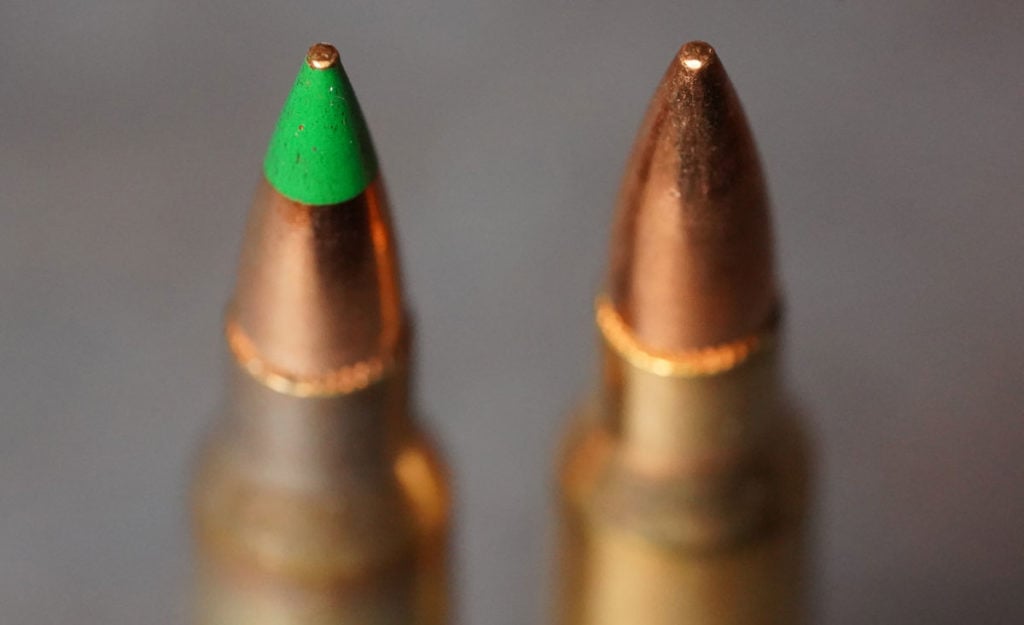
Many believe green-tipped 5.56 NATO rounds are armor-penetrating, but that’s a misconception. The steel used in the M855 core is actually softer than the one typically used in armor plates. Softer steel versus harder steel? The logic suggests the latter wins.
However, the M855 is still effective against other hard objects, such as cinder blocks. On the other hand, once an M193 bullet hits a hard target, its lead core disintegrates and deforms earlier, which adversely impacts penetration.
Despite the inferior penetrating capabilities of a lead core, a higher velocity of a lighter M193 bullet makes the cartridge suitable for situations where you need a projectile that flies faster and longer. At short range, say 100 yards, it shows a pretty decent penetration. Plus, M193 bullets tend to fragment upon impact, causing tissue damage and ultimately making the 5.56 M193 round a viable option for home defense.
M855:
- Designed for penetration and long-range performance.
- Features a 62-grain green-tipped bullet with a steel core and copper jacket.
- Effective at penetrating thin metals, thick clothing, and brush cover but struggles with harder barriers (e.g., auto glass, body armor).
- Less suited for self-defense due to a tendency to pass through targets without significant tissue damage.
- Requires a faster barrel twist rate (1:7 or 1:8) for proper stabilization.
M193:
- Standard U.S. military ammunition until the 1980s.
- Features a lighter 55-grain full metal jacket round.
- Known for its ability to fragment upon impact, causing more tissue damage when unimpeded.
- Less effective at penetrating cover or barriers (e.g., metal, foliage).
- Compatible with a wider variety of barrel twist rates (e.g., 1:12), making it versatile for civilian-use firearms.
Is M193 5.56 Ball Ammo Suitable for Home Defense?
When evaluating 5.56 ammo for home defense, M193 full metal jacket rounds often come into the discussion due to their affordability and widely known performance characteristics. But is ball ammo suitable for home defense? Surprisingly, it can be.
The 5.56 NATO, being a military cartridge, means most 5.56 ammo offerings will be FMJ. Why do the military use FMJs that don’t expand and can overpenetrate? Mainly it’s because it’s cheaper and feeds more reliably. It’s also because the Hague Conventions forbids the use of projectiles that expand and flatten in the human body and cause unnecessary suffering as the warfare isn’t about killing all your enemies but rather forcing them out of action.
Now, let’s discuss the use of 5.56 ball ammo for civilian defense. First of all, do not use 5.56 M855 ammo for home defense. Featuring a steel core and a jacketed bullet, this cartridge was intended to penetrate barriers like thin metals, thick clothing, and brush cover and it doesn’t fragment, which means it poses a risk of overpenetration in practical home defense scenarios. It’s a good military cartridge, but bad for home defense.
What about the M193 5.56 for home defense? One distinct characteristic of M193 is its tendency to tumble and fragment upon hitting softer barriers, such as drywall. Fragmentation reduces the bullet’s speed and energy, posing less risk of over-penetration compared to the heavier M855 green tip rounds or 9mm FMJ handgun ammo.
That said, proper shot placement remains critical since nearly all rounds will penetrate drywall to some extent.
However, reliable fragmentation is only achievable with AR15 rifles with barrels 14.5 inches or longer because they can produce enough velocity. When a M193 5.56 bullet impacts a target with a velocity of above 2,700 fps, the bullet rapidly yaws within soft tissue, creating large wound channels. This makes it effective for neutralizing threats in typical home-defense distances, which are often within 50 yards.
On the other hand, fired from a shorter barrel (10.5″ or 11.5″ SBRs), the bullet often fails to achieve 2,700 fps, and ability to fragment becomes unreliable, resulting in shallow, narrow wound channels and potentially overpenetration.
So while M193 5.56 ammo is affordable and accessible, for home defense, it’s better to opt for purpose-built defensive loads designed for controlled expansion and reduced over-penetration. These rounds balance effectiveness and safety, making them well-suited for indoor use or areas with close-proximity neighbors.
M855 Best Applications:
- Ideal for military or defense scenarios requiring penetration.
- Effective for longer ranges and overcoming environmental challenges like wind.
M193 Best Applications:
- Perfect for training, range shooting, and short-range hunting.
- Can be used for self-defense due to its fragmentation and tissue damage potential.
- More affordable and widely available.
Best 5.56 Bulk / FMJ Ammo
Winchester 5.56 NATO M193 55gr FMJ
Winchester M193 55gr FMJs are widely regarded as one of the best bulk options for range use and general plinking especially one produced in Lake City. It is a true full-power M193 load, known for its reliability and consistent performance, even out to 500 yards on torso-sized targets. The box contains 5.56 rounds with 55-grain full metal jacket bullets that exit the muzzle at a speed of 3270 fps with an energy of 1306 ft/lb.
- Pros: True M193 spec, reliable ignition, good velocity, widely available.
- Cons: Not the most accurate for precision shooting, but more than adequate for training and drills.

WINCHESTER 5.56mm 55gr FMJ 1000/Box
$542.08
Price accurate at time of writing
- Caliber: 5.56x45mm NATO
- Bullet: 55gr FMJ
- Muzzle velocity: 3270 fps
- Muzzle energy: 1306 ft/lbs
- Rounds per box: 1000

WINCHESTER 5.56mm 55gr FMJ 200/Box
$124.99
Price accurate at time of writing
- Caliber: 5.56x45mm NATO
- Bullet: 55gr FMJ
- Muzzle velocity: 3270 fps
- Muzzle energy: 1306 ft/lbs
- Rounds per box: 200
To wring out the most accuracy of 55-grain ammo, you need to fire it from a barrel with a slower twist rate of 1/9. A faster twist rate and a faster velocity will cause overstabilization leading to messed-up shot placement.
Winchester 5.56 NATO M855 62gr FMJ LC
Want the famous lead-core M855 ammo? Winchester’s 62-grain rounds are the best 5.56 rounds for the 5.56 1×8 and 1×9 barrel since a faster twist rate does a better job at stabilizing heavier bullets. These bullets generate 3060 fps of muzzle velocity and 1289 ft/lb of muzzle energy.
- Pros: Reliable ignition, good velocity, widely available.
- Cons: 62gr contains steel penetrator core, which can be restricted at some indoor ranges.

WINCHESTER 5.56mm 62gr M855 green-tip FMJ 1000/Box
$504.37
Price accurate at time of writing
- Caliber: 5.56x45mm NATO
- Bullet: 62gr FMJ
- Muzzle velocity: 3060 fps
- Muzzle energy: 1289 ft/lbs
- Rounds per box: 1000
PMC X-TAC 55gr & 62gr FMJ
PMC X-TAC offers both 55gr FMJ (M193) and 62gr “green tip” (M855) loads. These are praised for their reliability and clean shooting. Many shooters report thousands of rounds fired without issues, making PMC a staple for bulk purchases and range use.
- Pros: Consistent quality, reliable cycling, available in both 55gr and 62gr.
- Cons: 62gr contains steel penetrator core, which can be restricted at some indoor ranges.
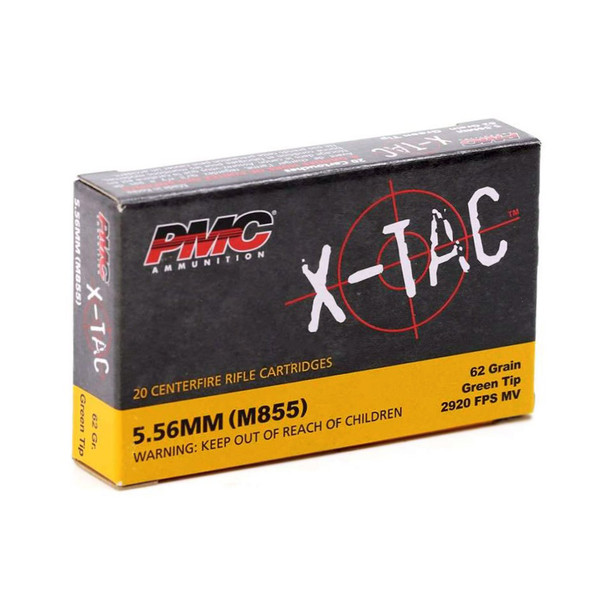
PMC X-Tac 5.56mm 62gr Green Tip FMJ 20/Box
$23.24
Price accurate at time of writing
- Caliber: 5.56x45mm NATO
- Bullet: 62gr LAP
- Muzzle velocity: 3100 fps
- Muzzle energy: 1323 ft/lbs
- Rounds per box: 20

PMC X-TAC 5.56NATO 55gr FMJ-BT 20/Box (50 boxes)
$451.53
Price accurate at time of writing
- Caliber: 5.56x45mm NATO
- Bullet: 55gr FMJ-BT
- Muzzle velocity: 3120 fps
- Muzzle energy: 1316 ft/lbs
- Rounds per box: 20 (50 boxes)
Federal American Eagle 55gr & 62gr FMJ
Federal’s American Eagle line is a go-to for affordable 5.56 ammo. It’s widely available, functions well in most AR-15 platforms, and is a solid choice for high-volume shooters looking for dependable performance.
- Pros: Affordable, reliable, widely available.
- Cons: Not match-grade accurate, but sufficient for general range use.

FEDERAL American Eagle 223 Rem 55gr FMJ 20/Box
$27.47
Price accurate at time of writing
- Caliber: 223 Rem
- Bullet: 55gr FMJ BT
- Muzzle velocity: 3240 fps
- Muzzle energy: 1282 ft/lbs
- Rounds per box: 20
Magtech 5.56 FMJ
Magtech’s 5.56 FMJ, especially older military production lots, is recommended for bulk purchases. It is well-sealed for long-term storage and provides reliable function for training and practice.
- Pros: Good for long-term storage, reliable ignition.
- Cons: Some lots can be older, but still perform well.

MAGTECH First Defence Tactical 5.56mm 62Gr FMJ 50/Box
$36.59
Price accurate at time of writing
- Caliber: 5.56 NATO
- Bullet: 62gr FMJ
- Muzzle velocity: 3100 fps
- Muzzle energy: 1323 ft/lbs
- Rounds per box: 50

MAGTECH CBC 5.56mm 55Gr FMJ 50/Box
$30.90
Price accurate at time of writing
- Caliber: 5.56 NATO
- Bullet: 55gr FMJ
- Muzzle velocity: 3265 fps
- Muzzle energy: 1302 ft/lbs
- Rounds per box: 50
Best 5.56 Defense Ammo
Hornady Critical Defense 55gr FTX
Hornady’s Critical Defense line uses a polymer-tipped hollow point designed for rapid expansion and reduced risk of over-penetration. It’s optimized for home defense scenarios where minimizing risk to bystanders is important.
- Pros: Reduced penetration, rapid expansion, low flash powder.
- Cons: Not barrier blind, less effective against hard cover.

HORNADY Critical Defense 223 Rem 55gr FTX 20/Box
$37.58
Price accurate at time of writing
- Caliber: .223 Remington
- Bullet: 55gr FTX
- Muzzle velocity: 3240 fps
- Muzzle energy: 1282 ft/lbs
- Rounds per box: 20
Federal Fusion MSR 62gr
Federal Fusion MSR is a bonded soft point round designed for modern sporting rifles. It offers controlled expansion and deep penetration, making it suitable for both home defense and hunting.
- Pros: Good expansion, reliable performance, barrier blind.
- Cons: Slightly less expansion than some dedicated hollow points.

FEDERAL Fusion MSR 223 Rem. 62 gr Soft Point 20/Box
$40.32
Price accurate at time of writing
- Caliber: .223 Remington
- Bullet: Soft Point
- Muzzle velocity: 2750 fps
- Muzzle energy: 1041 ft/lbs
- Rounds per box: 20
Hornady Black 75gr Interlock SBR
Specifically engineered for short-barreled rifles, this round uses a heavy bullet and low-flash powder to maximize terminal performance from barrels as short as 10.5 inches. It is barrier blind and offers excellent wound channels.
- Pros: Optimized for SBRs, barrier blind, low flash.
- Cons: Some users report it as slightly underpowered, but still effective.

HORNADY Black 5.56 NATO 75gr InterLock 20/Box
$35.05
Price accurate at time of writing
- Caliber: 5.56 NATO
- Bullet: 75gr InterLock
- Muzzle velocity: 2321 fps
- Muzzle energy: 897 ft/lbs
- Rounds per box: 20
Barnes Vor-TX 55gr TSX FB (Triple-Shock X Flat Base)
This all-copper hollow point bullet is lead-free and designed for deep penetration and controlled expansion with less risk of fragmentation. The 55gr TSX is effective in defensive scenarios, especially when barrier penetration is a concern, and is also legal in lead-restricted areas.
- Pros: Lead-free, reliable expansion, deep penetration, barrier blind.
- Cons: Expensive, less dramatic wound cavity compared to lead-core bullets.

Barnes VOR-TX 223 Rem 55gr Triple Shock X 20/Box
$42.96
Price accurate at time of writing
- Caliber: 223 Remington
- Bullet: 55gr TSX flat base
- Muzzle velocity: 3240 fps
- Muzzle energy: 1282 ft/lbs
- Rounds per box: 20
Best 5.56 Hunting Ammo
Federal Power-Shok 64gr Soft Point
This round is a versatile hunting load that bridges the gap between lighter varmint rounds and heavier match or specialized hunting bullets. It offers a balance of high velocity (around 3050-3090 fps muzzle velocity) and controlled expansion, allowing it to penetrate dense muscle and hide without excessive fragmentation. Can be used for deer hunting.
- Pros: Affordable, versatile, reliable expansion, widely available.
- Cons: Potential for overpenetration on small game or close-range shots.
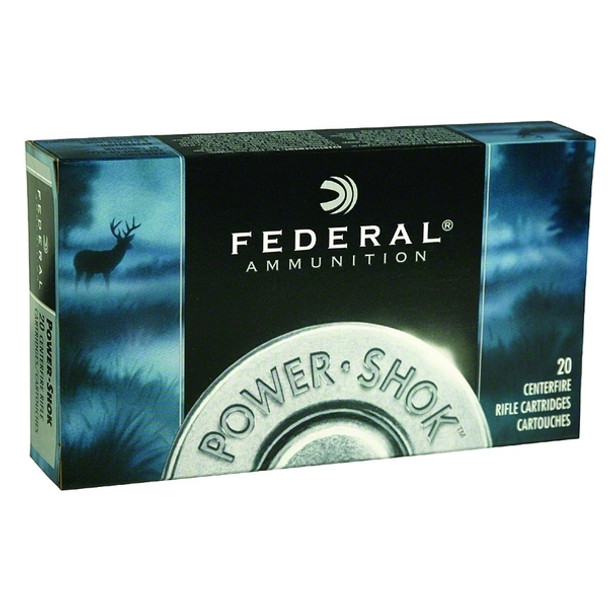
FEDERAL Power-Shok 223 Rem 64gr Soft Point 20/Box
$32.49
Price accurate at time of writing
- Caliber: 223 Remington
- Bullet: 64gr Soft Point
- Muzzle velocity: 3090 fps
- Muzzle energy: 1357 ft/lbs
- Rounds per box: 20
Remington AccuTip .223 55gr
Remington AccuTip is a polymer-tipped, boat-tail bullet designed for rapid expansion and high accuracy. Like the Varmint X, it excels at varmint and predator hunting, providing explosive expansion and fragmentation on small game. The 55gr weight offers a bit more penetration than lighter varmint bullets, making it slightly more versatile for larger predators such as coyotes or foxes, but it’s still not recommended for deer-sized game due to its tendency to fragment and lack of deep penetration.
- Pros: Excellent accuracy, rapid expansion thanks to polymer tip.
- Cons: Not ideal for larger game due to fragmentation.

REMINGTON Premier AccuTip-V 223 Rem 55gr 20/Box
$38.41
Price accurate at time of writing
- Caliber: 223 Remington
- Bullet: 55gr AccuTip-V
- Muzzle velocity: 3240 fps
- Muzzle energy: 1282 ft/lbs
- Rounds per box: 20
Winchester Varmint X 223 Rem 40gr
This round is engineered for varmint hunting. The 40gr polymer-tipped bullet offers extremely high velocity (up to 3700 fps), rapid expansion, and explosive fragmentation upon impact. The thin alloy jacket and soft lead core are designed to maximize energy transfer and create massive trauma, making it highly effective on small game like prairie dogs and ground squirrels. The light bullet weight and rapid fragmentation, however, result in shallow penetration, which is not suitable for larger game.
- Pros: Excellent accuracy, rapid expansion thanks to polymer tip.
- Cons: Not ideal for medium or big game due to fragmentation.
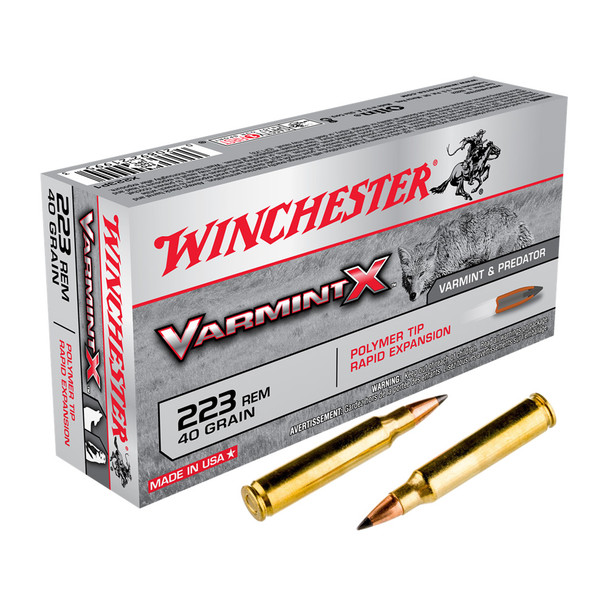
WINCHESTER AMMO Varmint X 223 Rem 40Gr Polymer Tip /Box
$33.04
Price accurate at time of writing
- Caliber: 223 Remington
- Bullet: 55gr Polymer Tip
- Muzzle velocity: 3600 fps
- Muzzle energy: 1151 ft/lbs
- Rounds per box: 20
Sierra Tipped MatchKing 77-grain TMK
The Sierra Tipped MatchKing 77-grain TMK is a solid choice for .223 deer hunting. At 77 grains, the TMK is heavier than standard .223 bullets, providing better penetration and energy retention. However, these bullets require a fast-twist barrel.
- Pros: Reliable expansion and deep penetration, high accuracy, suitable for deer hunting.
- Cons: Expensive, requires a faster twist rate.

SIERRA Tipped MatchKing .22 Caliber .224" 77Gr TMK 500/Box Reloading Bullets
$182.74
Price accurate at time of writing
- Caliber: .22 caliber (0.224")
- Bullet: 77gr Tipped MatchKing
- Bullet only, not live ammo.
5.56 NATO Reloading
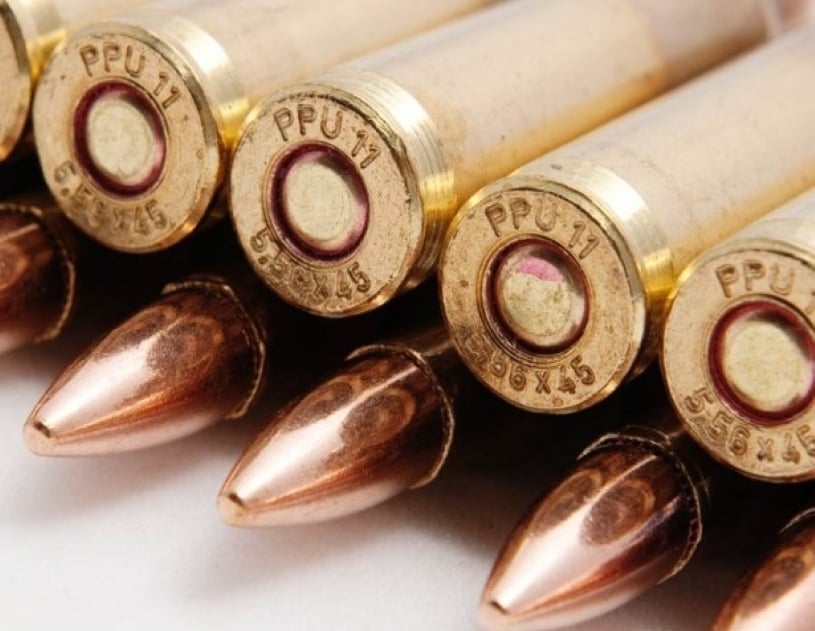
Many shooters wonder if they can and how to reload 5.56 ammo. Well, reloading is a great idea because it helps you save some money you would otherwise spend on new rounds. The brass used to manufacture cases is not getting any cheaper, while cases make a big cost of ammo. Besides, the AR ammo is always in high demand, which means sometimes it can disappear from store shelves. Also, consider the overall ammo shortage. The average price for 5.56 ammo fluctuates between $0.35 and $0.55 per round. Reloading can help lower the training and plinking cost.
Military cartridges are typically harder to reload because of the primer pocket type. Unlike civilian cartridges that use rolled pockets, military rounds often have their primer pockets crimped for increased reliability and durability. To reload a 5.56 NATO round, you’ll need to decrimp the primer pocket with a chamfering tool or a swager tool.
When reloading, remember that 5.56 NATO and .223 Remington are different cartridges, and while their reloading processes are pretty similar and require the same reloading dies, load data for them differs. So use appropriate data for the case you’re loading and don’t interchange.
We hope this guide will be helpful to novice shooters trying to make things clear and advanced gun owners who have more specific questions about the 5.56x45mm NATO. If you’re wondering where you can buy 5.56 ammo, look no further. Gritr Sports carries a variety of 5.56 NATO ammo from reputable brands, such as Winchester, Hornady, Federal, PMC, and others.
FAQs
Since 5.56 is basically the same round as the .223 Rem, we’d recommend you search for expandable .223 Rem hunting rounds with high penetration, such as the Remington Accutip or Nosler Expansion Tip. The 5.56 is a military cartridge, which means it’s available with non-expandable monolithic bullets – these aren’t recommended for hunting.
For deer hunting, you’d typically want a round with good penetration and expansion. The 5.56 NATO cartridge is a military ball round with a non-expandable FMJ bullet. They can overpenetrate on impacts and, thus, fail to cause enough tissue damage. Instead, we recommend expansion-tip .223 Rem ammunition for deer hunting. Also, don’t forget to check hunting laws and regulations in your area – some states prohibit hunting using 5.56 ammo.
The best 5.56mm defense ammo is usually one that offers reliable expansion and penetration, meaning, it should be .223 Rem, not 5.56 NATO. The Hornady TAP is highly regarded in this respect.
5.56 NATO ammo with FMJ bullets isn’t suitable for home defense because they don’t expand on impact and can overpenetrate, especially the M855. On the other hand, the expandable .223 Rem is a great choice for home-defense. 5.56 M193 can be used for home defense, but only if you can achieve reliable fragmentation with your setup.









Leave a Reply